During spring and summer in Nevada, when the warblers make their appearance, it’s common to spot yellow birds, particularly the Yellow-rumped Warbler and Lesser Goldfinch in winter. To assist you in identifying these yellow birds in Nevada, this comprehensive guide offers pictures, identification details, song recordings, and migration patterns.
The majority of yellow birds found in Nevada are warblers, orioles, or tanagers, with some females looking distinctively different from the males of their species. With the abundance of information provided in this guide, identifying yellow birds becomes much easier. The yellow birds are listed in order of their common occurrence in Nevada during spring and summer, based on ebird checklists from May and June.
Yellow birds found in Nevada throughout the year include the Yellow-rumped Warbler, Lesser Goldfinch, Western Meadowlark, Orange-crowned Warbler, American Goldfinch, and Cedar Waxwing. During the summer, Western Kingbird, Yellow Warbler, Yellow-headed Blackbird, Western Tanager, Common Yellowthroat, Wilson’s Warbler, Hooded Oriole, Nashville Warbler, Summer Tanager, Scott’s Oriole, and Hooded Warbler make appearances. Lastly, the migration season brings Evening Grosbeak, American Redstart, and Prothonotary Warbler to Nevada.
Continue reading to accurately identify the yellow birds you’ve spotted. The guide presents a list of 20 yellow birds in Nevada, accompanied by detailed descriptions and fascinating facts about each species.
1. Yellow-rumped Warbler
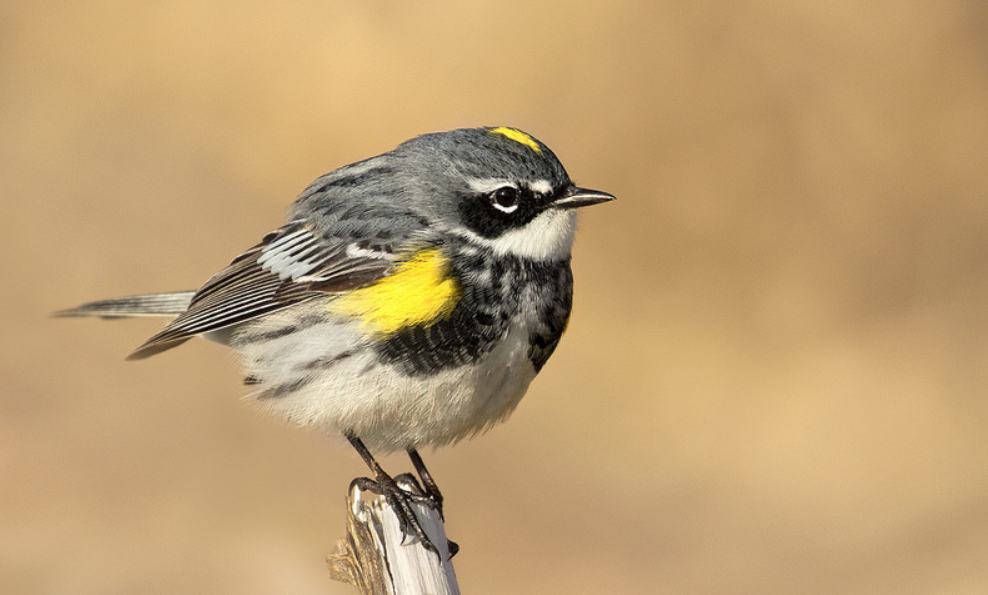
Yellow-rumped Warblers are more commonly observed in Nevada during winter, but some also stay in the northern regions of the state for breeding. Summer checklists from birdwatchers reveal their presence in 11% of submissions, while winter checklists show a higher occurrence at 28%.
These warblers display gray plumage with touches of yellow on their face, sides, and rump, while their wings appear white. Females may exhibit a slight brownish hue, and winter individuals feature paler brown shades with vibrant yellow rumps and sides that transition back to gray and yellow in spring.
Scientific name: Setophaga coronata
Size: 4.7-5.5 in (12-14 cm)
Weight: 0.4-0.5 oz (12-13 g)
Wingspan: 7.5-9.1 in (19-23 cm)
Yellow-rumped Warblers primarily breed in Canada, the Rockies, and the Appalachian mountains. During migration, they can be seen in the Midwest before overwintering in the southern and southwestern regions of the United States, along the Pacific Coast, and extending into Mexico and Central America.
These birds prefer coniferous forests, particularly during the breeding season, while they tend to inhabit open areas with fruiting shrubs in winter. Their diet consists mainly of insects during summer and migration, shifting to a predominantly fruit-based diet, including bayberry and wax myrtle, during winter.
2. Lesser Goldfinch

Lesser Goldfinches are present in Nevada throughout the year, with a higher occurrence in summer, as indicated by 14% of checklists, and a slightly lower presence in winter at 18%.
These tiny songbirds boast vibrant yellow plumage with contrasting black markings, long pointed wings, and short notched tails. While males exhibit a black back, females possess olive-colored backs and display a less intense shade of yellow on their undersides.
Scientific name: Spinus psaltria
Size: 3.5-4.3 in (9-11 cm)
Weight: 0.3-0.4 oz (8-11.5 g)
Wingspan: 5.9-7.9 in (15-20 cm)
Lesser Goldfinches reside year-round in the southwestern United States and along the West Coast. However, those that breed in the interior of western states embark on migratory journeys during winter.
These finches can be found in large flocks within open habitats like thickets, weedy fields, forest clearings, parks, and gardens. Their diet primarily consists of seeds, with a particular affinity for sunflower seeds. They also consume fruits from elderberry and coffeeberry, as well as buds from cottonwoods, willows, sycamores, and alders.
3. Western Meadowlark
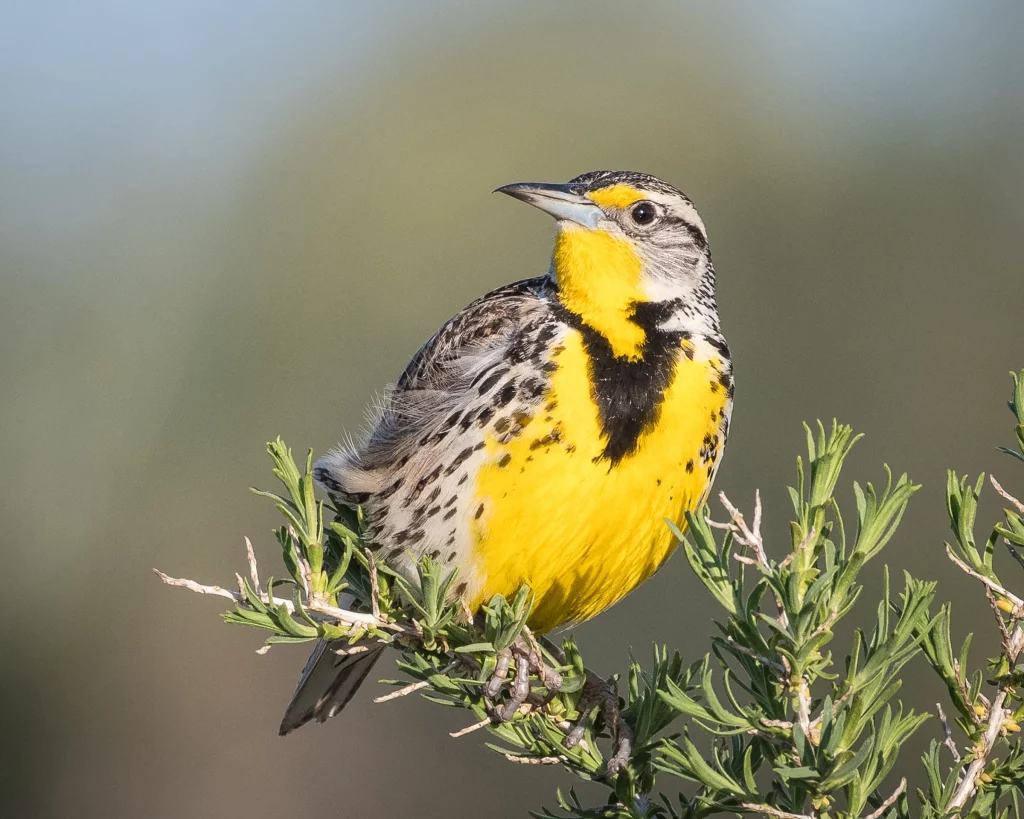
Western Meadowlarks can be observed year-round in Nevada, with a higher frequency during the breeding season. Summer checklists indicate their presence in 12% of submissions, while winter checklists document a lower occurrence at 5%.
These delightful birds, with their vibrant yellow bellies and melodious songs, can undoubtedly brighten any day. Western Meadowlarks belong to the blackbird family and display shades of brown and white on their upperparts, along with a distinctive black V-shaped band across their yellow chest, which fades to gray in winter.
Scientific name: Sturnella neglecta
Size: 6.3-10.2 in (16-26 cm)
Weight: 3.1-4.1 oz (89-115 g)
Wingspan: 16.1 in (41 cm)
While some Western Meadowlarks migrate to more southern states during winter, those located in the western and midwestern regions remain in Nevada throughout the year.
These birds primarily inhabit grasslands, meadows, and fields, often foraging on the ground. They prefer open areas and are not typically found in wooded or dense shrubby environments.
Western Meadowlarks exhibit an omnivorous diet, consuming insects and seeds. During summer, their diet leans more towards insects, while they consume a higher proportion of seeds and grain in winter.
4. Western Kingbird

Western Kingbirds are the most commonly sighted yellow birds in Nevada during summer, occurring in 17% of checklists at this time. They can be observed in the region from March to October.
These sizable flycatchers showcase yellow bellies, whitish chests, gray heads, grayish-brown wings, and black tails with distinctive white edges.
Scientific name: Tyrannus verticalis
Size: 7.9-9.4 in (20-24 cm)
Weight: 1.3-1.6 oz (37-46 g)
Wingspan: 15.0-16.1 in (38-41 cm)
Western Kingbirds breed during summer in western US states, the plains area, and into Canada. They undertake migration to Mexico and Central America, although some individuals may overwinter in the southern regions of Florida.
These birds favor open habitats and are often spotted perched on fences and utility lines, patiently awaiting passing insects that they capture in mid-flight.
5. Yellow Warbler
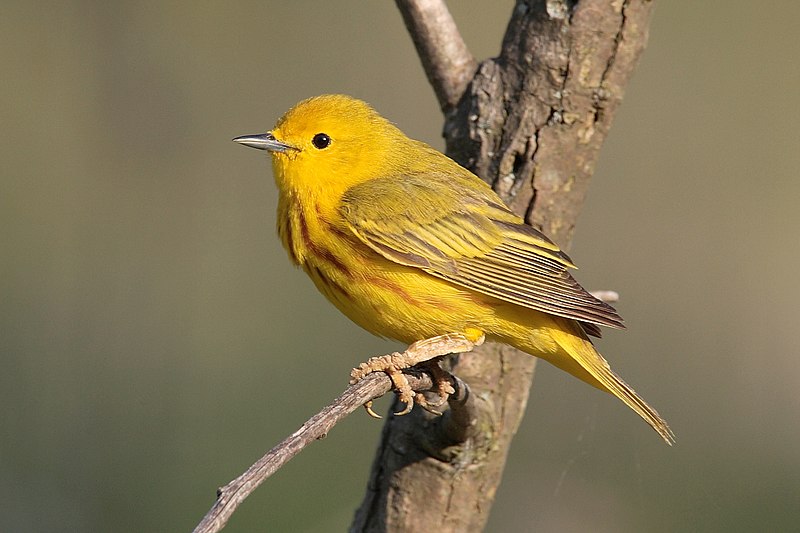
Yellow Warblers predominantly appear in Nevada from April to October, with their occurrence recorded in up to 15% of summer checklists.
These small, bright yellow birds possess yellow-green backs, and male individuals feature chestnut streaks on their breasts. Females and juveniles exhibit less vibrant colors compared to males.
Scientific name: Setophaga petechia
Size: 4.7-5.1 in (12-13 cm)
Weight: 0.3-0.4 oz (9-11 g)
Wingspan: 6.3-7.9 in (16-20 cm)
Yellow Warblers embark on long-distance migrations, breeding in Canada and the United States (excluding southeastern states) before venturing into Central
and South America for winter. During migration, they can also be spotted in southeastern US states.
These warblers can be found along streams, in wetlands, thickets, and along field edges, where they diligently forage for various insects such as caterpillars, midges, beetles, bugs, and wasps.
6. Yellow-headed Blackbird
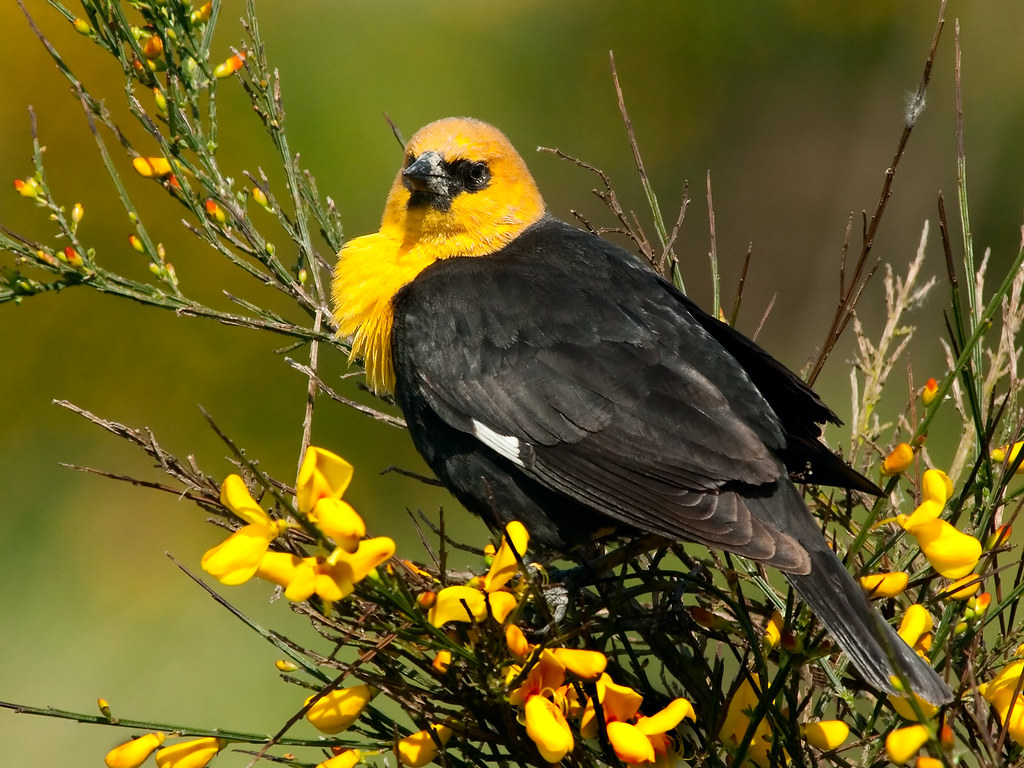
Yellow-headed Blackbirds are present in Nevada during summer, but their numbers increase during the spring and fall migration seasons. They feature in 10% of summer checklists and up to 15% of checklists during migration.
These striking birds showcase glossy black bodies, vibrant yellow heads and chests, and white wing patches in males. Females, on the other hand, exhibit brown plumage instead of black, with duller yellow heads. Yellow-headed Blackbirds are larger than Red-winged Blackbirds.
Scientific name: Xanthocephalus xanthocephalus
Size: 8.3-10.2 in (21-26 cm)
Weight: 1.6-3.5 oz (44-100 g)
Wingspan: 16.5-17.3 in (42-44 cm)
Yellow-headed Blackbirds breed in western and prairie wetlands, constructing nests within reeds. They forage over surrounding wetlands, grasslands, and fields, primarily feasting on insects during summer. After breeding, these blackbirds migrate to fields and farmland in the Southwest and Mexico, forming large winter flocks.
Their diet shifts to include seeds and grains during winter.
7. Orange-crowned Warbler
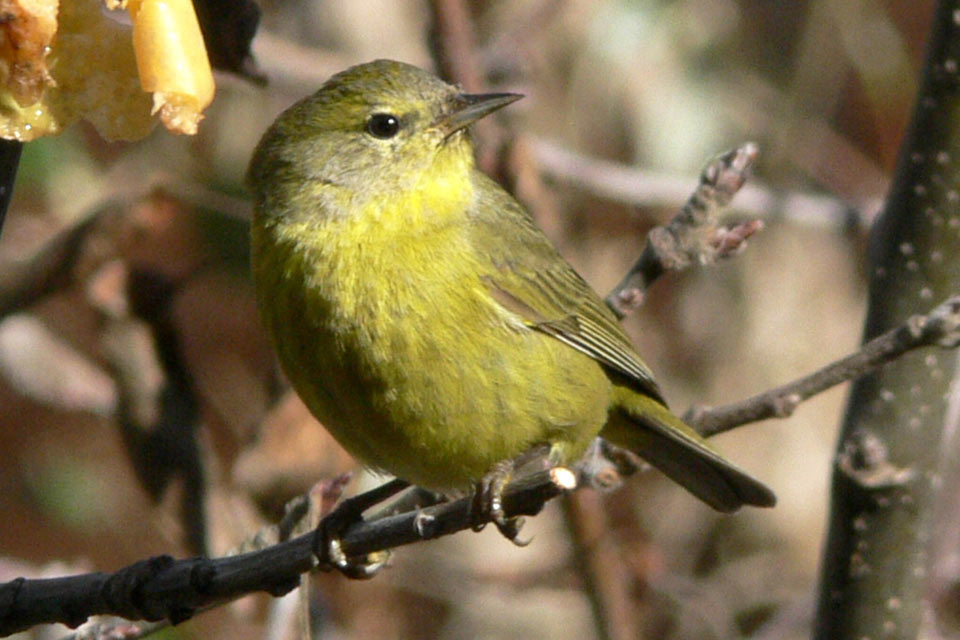
Orange-crowned Warblers are observed during the breeding season in northern Nevada, with their numbers increasing during fall migration. However, some individuals also spend the winter in the region. Their presence is recorded in 2% of summer checklists, 6% of winter checklists, and up to 31% of checklists during fall migration.
These warblers don’t possess the same vibrant colors as other members of their family. Instead, they exhibit yellow-olive plumage, which may appear more yellow along the Pacific Coast. The orange crown, which gives them their name, is rarely visible.
Scientific name: Leiothlypis celata
Size: 4.3-5.5 in (11-14 cm)
Weight: 0.3-0.4 oz (7-11 g)
Wingspan: 7.5 in (19 cm)
Orange-crowned Warblers breed in Canada, western US states, and migrate to the Pacific, East, and Gulf Coasts, as well as Mexico. During migration, they can be seen across all US states except the northeastern region.
These warblers prefer shrubby and low-lying vegetation, although they breed in open woodlands. Their diet primarily consists of spiders and insects like caterpillars and flies. Additionally, they show a fondness for fruits, berries, and seeds, making occasional visits to backyard feeders.
8. Western Tanager

Western Tanagers are spotted in Nevada during the breeding season, with their numbers increasing during the May and September migrations. They are recorded in 12% of summer checklists and up to 21% of checklists during migration.
Male Western Tanagers display a fiery orange-red head, yellow body, and black wings. Females possess red faces and exhibit yellow-green bodies.
Scientific name: Piranga ludoviciana
Size: 6.3-7.5 in (16-19 cm)
Weight: 0.8-1.3 oz (24-36 g)
Western Tanagers breed in western US states and western Canada. During migration, they can be seen in the eastern and southern regions of their range. These birds spend the winter in Mexico and Central America.
They primarily inhabit open coniferous forests, although they tend to remain hidden within the canopy despite their vibrant colors. Interestingly, Western Tanagers have experienced population growth over the past four decades.
During summer, they feed mainly on insects such as wasps and grasshoppers. In the fall and winter, they incorporate fruits into their diet.
9. Common Yellowthroat

Common Yellowthroats can be observed in Nevada from March to November, with a presence in 6% of summer checklists.
These small songbirds exhibit brownish plumage on their back and vibrant yellow undersides, accompanied by long tails. Male individuals sport black masks across their faces, while the brightness of the yellow plumage may vary geographically, sometimes appearing more olive-toned underneath.
Scientific name: Geothlypis trichas
Size: 4.3-5.1 in (11-13 cm)
Weight: 0.3-0.3 oz (9-10 g)
Wingspan: 5.9-7.5 in (15-19 cm)
Common Yellowthroats breed across most of North America (excluding Alaska and northern Canada) during the summer. Some individuals remain year-round along the Gulf Coast and Pacific Southwest, while others migrate south for winter.
These birds are commonly found in marshy or wetland areas and brushy fields, favoring thick and tangled vegetation.
10. Wilson’s Warbler
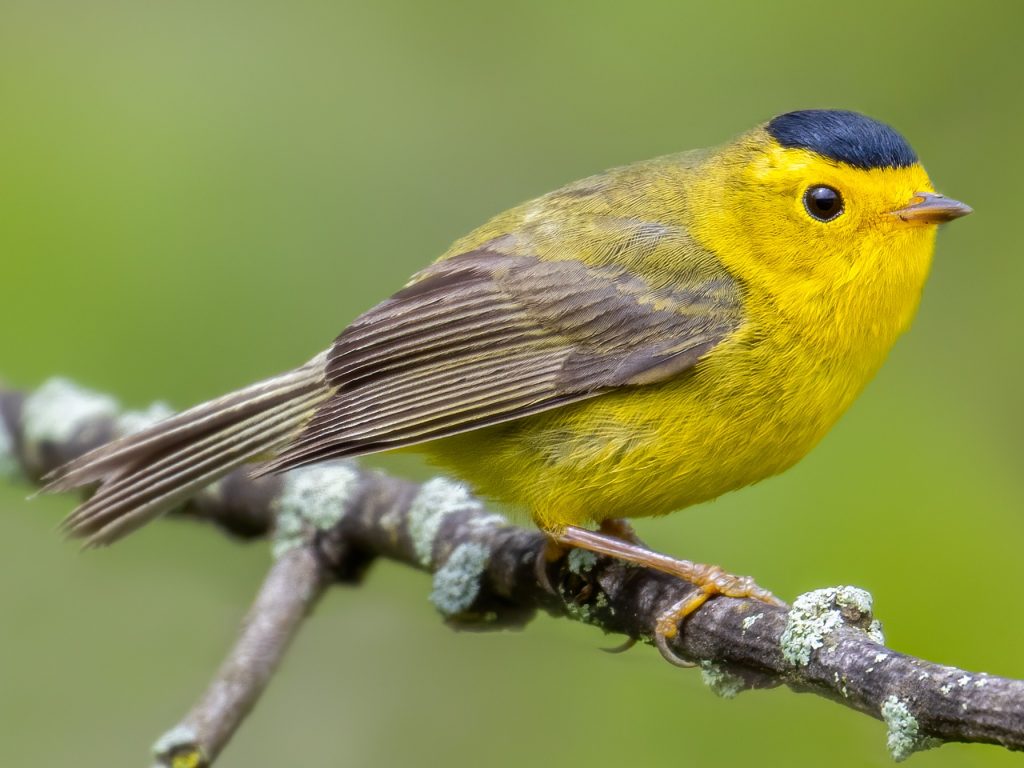
Wilson’s Warblers spend the breeding season in Nevada, and their numbers increase during the May and September migrations. They are recorded in 8% of summer checklists and up to 21% of checklists during migration.
Wilson’s Warblers are small, round yellow warblers with a large black cap in males and a smaller black cap in females.
Scientific name: Cardellina pusilla
Size: 3.9-4.7 in (10-12 cm)
Weight: 0.2-0.3 oz (5-10 g)
Wingspan: 5.5-6.7 in (14-17 cm)
Wilson’s Warblers breed in Canada, Alaska, and northwestern US states. They can also be seen across all US states during migration. During winter, they migrate to Mexico and Central America.
These warblers can be found along streams, in thickets, and near forest edges, foraging for insects and their larvae, as well as spiders.
11. Hooded Oriole
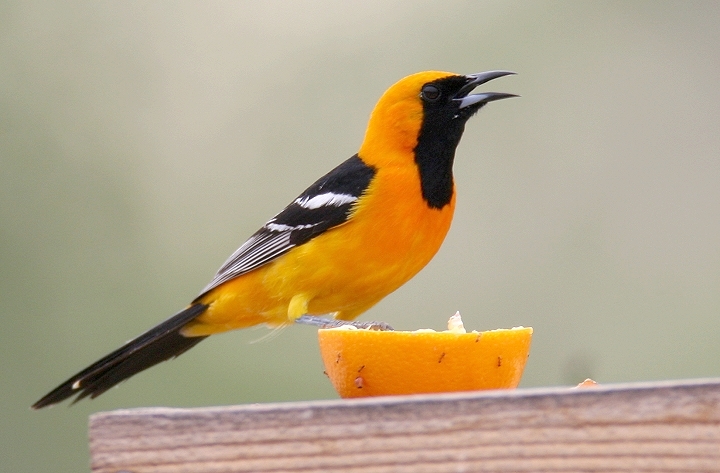
Hooded Orioles are summer visitors to Nevada, and they occur in up to 15% of summer checklists.
Male Hooded Orioles have bright yellow bodies with black wings and a black mask, while females exhibit a duller yellow coloration.
Scientific name: Icterus cucullatus
Size: 7.5 in (19 cm)
Weight: 0.8-1 oz (23-28 g)
Wingspan: 10-11 in (25-28 cm)
Hooded Orioles breed in the southwestern US states and Mexico. They can be found in open woodlands, gardens, and parks, where they feed on nectar, insects, and fruit.
12. Nashville Warbler
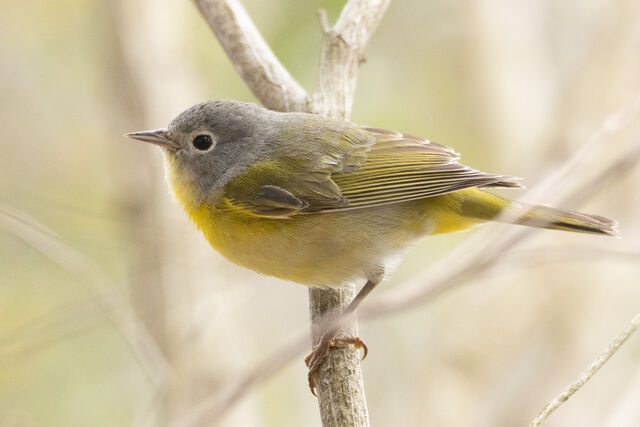
Nashville Warblers are migratory birds that pass through Nevada during their migration in spring and fall. They are observed in up to 21% of checklists during migration.
These warblers have olive-green upperparts and a bright yellow underside. They also possess a gray hood and a prominent white eye-ring.
Scientific name: Leiothlypis ruficapilla
Size: 4.3-4.7 in (11-12 cm)
Weight: 0.3-0.4 oz (9-11 g)
Wingspan: 6.3-7.1 in (16-18 cm)
Nashville Warblers breed in northern US states and Canada. During migration, they can be seen across the United States, except for the southwestern region.
13. Summer Tanager
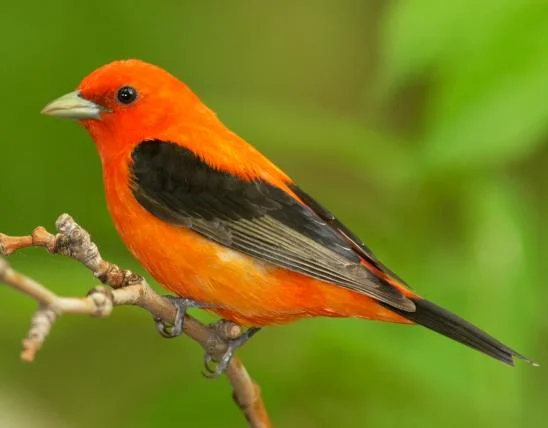
Summer Tanagers are migratory birds that pass through Nevada during their migration in spring and fall. They are recorded in up to 21% of checklists during migration.
Male Summer Tanagers exhibit a vibrant red plumage, while females have a yellowish-green coloration.
Scientific name: Piranga rubra
Size: 7.1 in (18 cm)
Weight: 1.1-1.4 oz (32-40 g)
Wingspan: 11.8 in (30 cm)
Summer Tanagers breed in the southeastern US states and parts of Mexico and Central America. They can be found in open woodlands and forests, where they feed on insects and fruit.
14. Scott’s Oriole
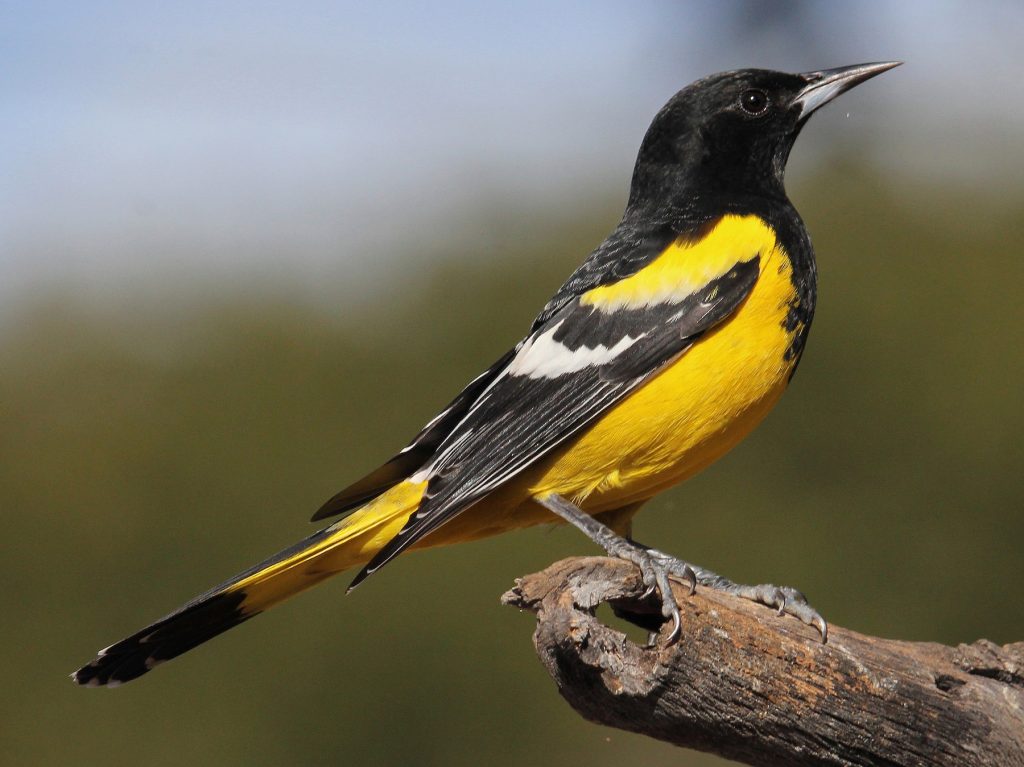
Scott’s Orioles are summer visitors to Nevada, and they occur in up to 15% of summer checklists.
Male Scott’s Orioles have bright yellow bodies with black wings and tail feathers. Females have a more olive coloration.
Scientific name: Icterus parisorum
Size: 7-8 in (18-20 cm)
Weight: 1-1.3 oz (29-37 g)
Wingspan: 11-12 in (28-30 cm)
Scott’s Orioles breed in the southwestern US states and parts of Mexico. They prefer desert scrub and open woodlands, where they feed on nectar, insects, and fruit.
15. Hooded Warbler
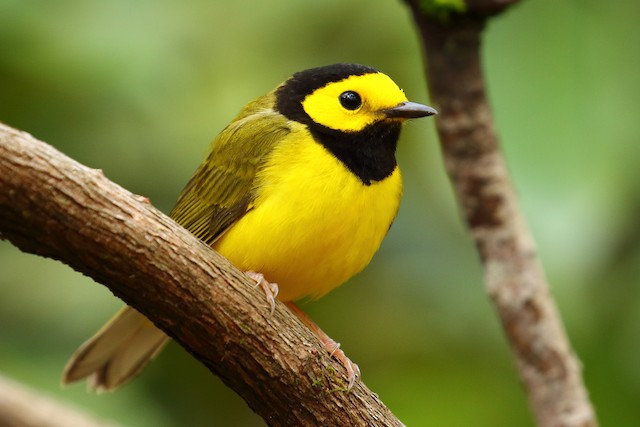
Hooded Warblers pass through Nevada during their migration in spring and fall, with sightings recorded in up to 21% of checklists during migration.
Male Hooded Warblers have a black hood and bib, a bright yellow face, and a yellow-green body. Females have a duller coloration.
Scientific name: Setophaga citrina
Size: 4.3-5.1 in (11-13 cm)
Weight: 0.3-0.4 oz (9-11 g)
Wingspan: 6.3-7.1 in (16-18 cm)
Hooded Warblers breed in the eastern US states and parts of Canada. During migration, they can be seen across the eastern and central regions of the United States.
16. Evening Grosbeak

Evening Grosbeaks are winter visitors to Nevada, occurring in up to 28% of winter checklists.
These large finches have a stocky build, with a yellow body, black wings, and a prominent white patch on their black tail feathers.
Scientific name: Coccothraustes vespertinus
Size: 6.7-8.7 in (17-22 cm)
Weight: 1.8-2.3 oz (52-65 g)
Wingspan: 11.4-13.4 in (29-34 cm)
Evening Grosbeaks breed in the northern regions of North America and Canada. During winter, they undertake irruptive movements, often venturing south in search of food. They can be found in coniferous forests and feed on seeds, buds, and fruits.
17. American Redstart

American Redstarts pass through Nevada during their migration in spring and fall, with sightings recorded in up to 21% of checklists during migration.
Male American Redstarts have black upperparts with bright orange patches on their wings, tail, and sides. Females exhibit grayish plumage with yellow patches.
Scientific name: Setophaga ruticilla
Size: 4.3-5.1 in (11-13 cm)
Weight: 0.3-0.4 oz (9-11 g)
Wingspan: 6.3-7.5 in (16-19 cm)
American Redstarts breed in eastern US states and parts of Canada. During migration, they can be seen across the eastern and central regions of the United States.
18. Prothonotary Warbler
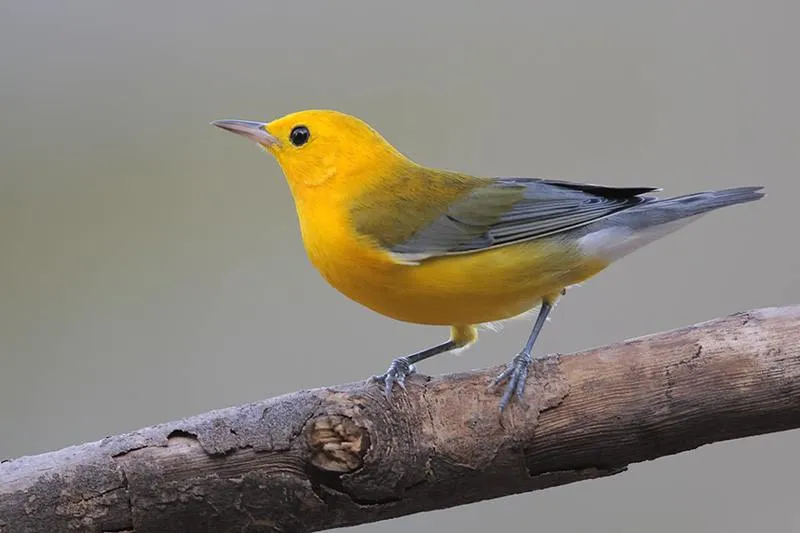
Prothonotary Warblers pass through Nevada during their migration in spring and fall, with sightings recorded in up to 21% of checklists during migration.
These warblers have vibrant yellow plumage and a distinctive blue-gray back.
Scientific name: Protonotaria citrea
Size: 4.3-5.1 in (11-13 cm)
Weight: 0.3-0.4 oz (9-11 g)
Wingspan: 7.5-8.7 in (19-22 cm)
Prothonotary Warblers breed in the southeastern US states and parts of Canada. During migration, they can be seen across the eastern and central regions of the United States.
19. American Goldfinch
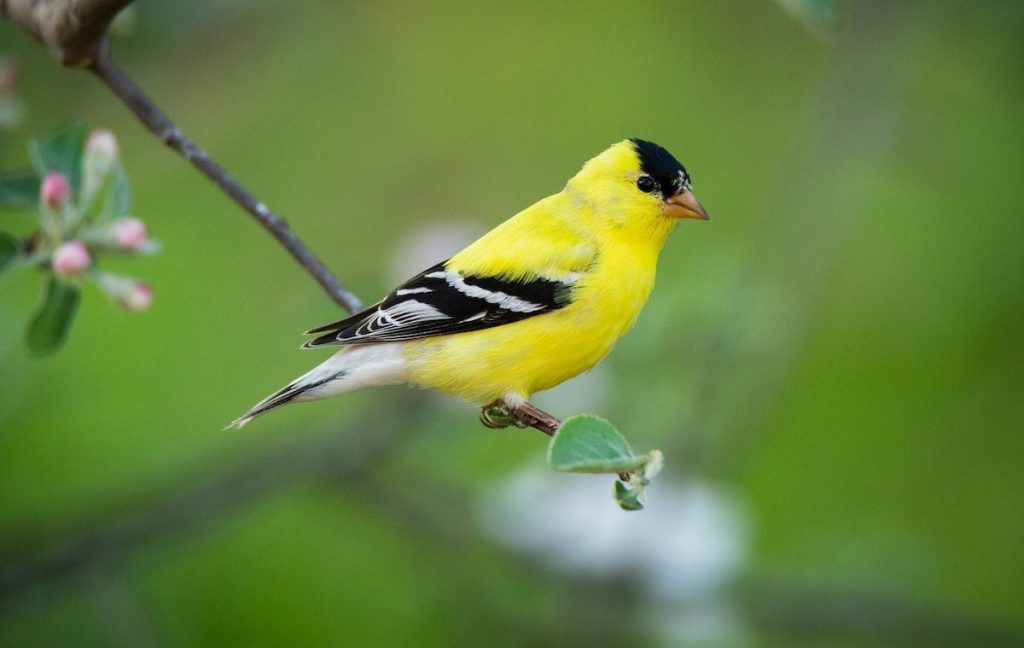
American Goldfinches can be observed in Nevada year-round, occurring in up to 12% of checklists.
These small finches display bright yellow plumage, with the males exhibiting a black cap during the breeding season.
Scientific name: Spinus tristis
Size: 4.3-5.1 in (11-13 cm)
Weight: 0.4-0.6 oz (11-17 g)
Wingspan: 7.5-8.7 in (19-22 cm)
American Goldfinches breed across most of North America, including parts of Canada. They can be found in various habitats, including open fields, meadows, and gardens, where they feed on seeds and plant material.
20. Cedar Waxwing

Cedar Waxwings can be observed in Nevada year-round, occurring in up to 12% of checklists.
These sleek songbirds have a unique plumage, with a yellowish belly, grayish-brown back, and a distinctive crest. They also feature black masks and waxy red tips on their secondary feathers.
Scientific name: Bombycilla cedrorum
Size: 6.3-7.1 in (16-18 cm)
Weight: 1.1-1.4 oz (30-40 g)
Wingspan: 9.8-11.8 in (25-30 cm)
Cedar Waxwings can be found in various habitats, including woodlands, orchards, and urban areas, where they feed on fruit, berries, and insects.
So there you have it! A comprehensive list of 20 yellow birds that can be spotted in Nevada throughout the year, during summer, and during migration. Enjoy birdwatching and marveling at the beauty of these feathered creatures in the Silver State!